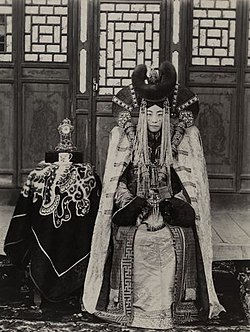This article needs additional citations for verification .(April 2024) |

The Mongolian nobility (Mongolian: ᠢᠵᠠᠭᠤᠷᠲᠠᠨ; yazgurtan; ᠰᠤᠷᠪᠤᠯᠵᠢᠲᠠᠨsurvaljtan) arose between the 10th and 12th centuries, became prominent in the 13th century, and essentially governed Mongolia until the early 20th century.
Contents
- Mongol Empire (1206–1368) and Yuan dynasty (1271–1368)
- Nobility titles
- Military Ranks
- Female titles
- Northern Yuan dynasty (1368–1635)
- Nobility titles 2
- Female titles 2
- Qing dynasty (1691–1911) and Bogd Khaganate (1911–1924)
- Nobility titles 3
- Generic titles
- Non-noble titles
- See also
- References
Many Mongol elites would end up assimilating into their Turkic subjects, adopting Islam and Turkic culture while retaining Mongol political and legal institutions. [1] These new Turco-Mongol elites would establish several successor states across the Muslim World.
The Mongolian word for nobility, Yazgurtan, derives from the Mongol word yazgur, meaning "root".



